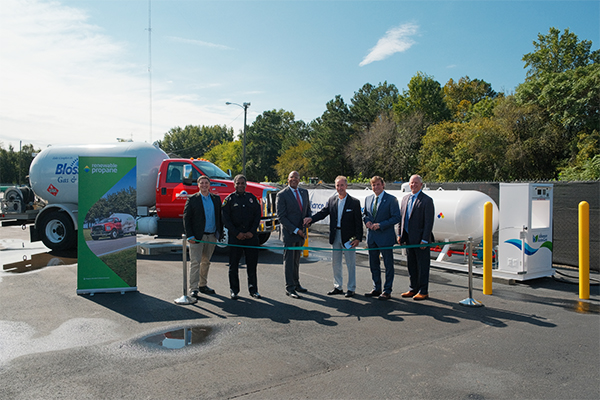Renewable propane enhances already-impressive vehicle display
On the surface, the propane industry event could have been viewed as another impressive display of propane-fueled fleet vehicles and equipment.

Petersburg Mayor Sam Parham, third from left, cuts the ribbon to celebrate the first gallons of renewable propane in the Commonwealth of Virginia. From left, Alleyn Harned, Virginia Clean Cities; Petersburg Police Chief Travis Christian; Parham; Virginia state Sen. Joseph Morrissey; Stuart Weidie of Blossman Gas/Alliance AutoGas; and Tucker Perkins of the Propane Education & Research Council (PERC). Photo by Will Rummel
That would have been all right. The industry welcomes any opportunity to show-and-tell about its advantages as a portable, reliable, low-cost, low-carbon energy source – and, in this case, one that can fuel a variety of vehicles and off-road equipment.
But when it gathered its national leaders in the Virginia city of Petersburg last month, alongside municipal and governmental officials, among Clean Cities representatives and fleet operators, to celebrate propane’s use as a vehicle fuel, the conversation didn’t center solely on conventional propane and autogas success stories. It centered on renewable propane.
“The story is so good with conventional propane, but to make it newsworthy and attention-getting we get to talk about what’s new and shiny,” says Tucker Perkins, president and CEO of the Propane Education & Research Council (PERC). “Renewable propane is on the scene as well.”
The industry built up the buzz about Virginia receiving its first load of renewable propane – supplied by Alliance AutoGas. The event also served indirectly as a response to those pushing wind and solar power in the state to say: There is another, cleaner option with propane.
Out for a test drive
In a way, you could say the industry is test-driving its “new and shiny” renewable offering. In the past couple of years, LPG leaders have underscored the need to develop a renewable component that complements conventional propane and gives it a seat at the policymaking table.
Renewable propane, with a carbon intensity four times lower than that of conventional propane and five times lower than diesel, is made from a mix of waste residues and sustainably sourced materials, including agricultural waste products, cooking oil and meat fats. In many cases, it’s a byproduct of renewable diesel and sustainable aviation fuel production.
Initially, industry leaders believed renewable propane would fit well in vehicle fuel applications, but Perkins says there’s also interest with forklifts and appliances.
Blossman Gas, the founding member of Alliance AutoGas, says it’s brought more than 12 million gallons of renewable propane into the transportation sector with Blue Star Gas, its West Coast partner. Suburban Propane, U-Haul, Roush CleanTech and SHV Energy are among other propane industry companies that have announced offerings related to renewable propane.
Energy leaders, including those from the propane industry, continue to look at the viability and production of renewable propane in the U.S.
We’ve come a long way
Five years ago, renewable propane wasn’t anywhere near the industry’s list of priorities.
PERC didn’t have an open statement about the renewable energy. Now, it has reached consensus on two things: Conventional propane still has a great story to tell. (PERC invested millions of dollars this year to rebrand conventional propane as “Energy for Everyone.”) Secondly, when the industry considers its energy future, it needs to bring renewable components into the fuel mix.
These components comprise what Perkins calls “precision energy.” He says the fuel of the future could have one of four components, which all work well together: propane, renewable propane, dimethyl ether (DME) and renewable DME. (DME is a molecule similar to propane that can be blended with LPG to lower its carbon footprint.)
Renewables aside, Perkins says, propane marketers must focus first on telling conventional propane’s positive environmental story. But know that renewable propane is here, and it should only gain ground as the industry builds relationships with producers.
The industry’s foundation has been built on “what propane can do.” That won’t change. But around the country, some may want to know “what renewable propane can do.”
We’re starting to learn what to tell them.
















